Nitrogen-Doped Titanium Dioxide Mixed with Calcium Peroxide and Methylcellulose for Dental Bleaching under Visible Light Activation
Abstract
1. Introduction
2. Results
2.1. X-ray Diffraction (XRD) Analysis
2.2. X-ray Photoelectron Spectroscopy (XPS) Analysis
2.3. Morphology Analysis
2.4. UV-Vis Absorption Spectra
2.5. Color Analysis of Tooth Bleaching
2.6. Biological Assays
3. Discussion
4. Materials and Methods
4.1. Preparation of N-TiO2
4.2. Characterization
4.3. Preparation of Stained Teeth
4.4. Color Analysis
4.5. Tooth Bleaching
4.6. Biological Assays
4.6.1. Cell Culture
4.6.2. Cell Viability
4.6.3. Cell Cytotoxicity
4.7. Statistical Analysis
5. Conclusions
Supplementary Materials
Author Contributions
Funding
Institutional Review Board Statement
Informed Consent Statement
Data Availability Statement
Acknowledgments
Conflicts of Interest
References
- Barry, T.; Bailey, C.; Ashcraft-Olmscheid, D.; Vandewalle, K. Effect of a new bleaching gel on tooth whitening. Oper. Dent. 2017, 42, 559–566. [Google Scholar] [CrossRef]
- Kurzmann, C.; Verheyen, J.; Coto, M.; Kumar, R.V.; Divitini, G.; Shokoohi-Tabrizi, H.A.; Verheyen, P.; De Moor, R.J.G.; Moritz, A.; Agis, H. In vitro evaluation of experimental light activated gels for tooth bleaching. Photochem. Photobiol. Sci. 2019, 18, 1009–1019. [Google Scholar] [CrossRef] [PubMed]
- Carey, C.M. Tooth whitening: What we now know. J. Évid. Based Dent. Pract. 2014, 14, 70–76. [Google Scholar] [CrossRef]
- Manuel, S.T.; Abhishek, P.; Kundabala, M. Etiology of tooth discoloration—A review. Etiol. Tooth Discoloration Rev. 2010, 18. [Google Scholar] [CrossRef]
- Bizhang, M.; Domin, J.; Danesh, G.; Zimmer, S. Effectiveness of a new non-hydrogen peroxide bleaching agent after single use—A double-blind placebo-controlled short-term study. J. Appl. Oral Sci. 2017, 25, 575–584. [Google Scholar] [CrossRef] [PubMed]
- Kwon, S.R.; Wertz, P.W. Review of the mechanism of tooth whitening. J. Esthet. Restor. Dent. 2015, 27, 240–257. [Google Scholar] [CrossRef]
- Kihn, P.W. Vital tooth whitening. Dent. Clin. N. Am. 2007, 51, 319–331. [Google Scholar] [CrossRef]
- Alqahtani, M.Q. Tooth-bleaching procedures and their controversial effects: A literature review. Saudi Dent. J. 2014, 26, 33–46. [Google Scholar] [CrossRef]
- Abdullah, A.O.; Muhammed, F.K.; Zheng, B.; Liu, Y. An overview of extrinsic tooth bleaching and its impact on oral restorative materials. World J. Dent. 2017, 8, 503–510. [Google Scholar] [CrossRef]
- Marson, F.; Gonçalves, R.; Silva, C.; Cintra, L.; Pascotto, R.; Dos Santos, P.H.; Briso, A.; Silva, C.; Cintra, L. Penetration of hydrogen peroxide and degradation rate of different bleaching products. Oper. Dent. 2015, 40, 72–79. [Google Scholar] [CrossRef]
- Sundfeld, R.; Neto, D.; Machado, L.; De Oliveira, F.; De Alexandre, R.; Palo, R.; Sundefeld, M.L.M.; Rh, S.; Ds, N.; Ls, M.; et al. Dental bleaching with a 10% hydrogen peroxide product: A six-month clinical observation. Indian J. Dent. Res. 2014, 25, 4. [Google Scholar] [CrossRef] [PubMed]
- European Commission. Scientific Committee on Consumer Products SCCP Opinion on Hydrogen Peroxide in Tooth Whitening Products. 2005. Available online: https://www.google.com.hk/url?sa=t&rct=j&q=&esrc=s&source=web&cd=&cad=rja&uact=8&ved=2ahUKEwjtn5yoh9rvAhWa_7sIHc_OB50QFjAAegQIAxAD&url=http%3A%2F%2Fec.europa.eu%2Fhealth%2Fph_risk%2Fcommittees%2F04_sccp%2Fdocs%2Fsccp_cons_01_en.pdf&usg=AOvVaw3CMBtpf_qa6iSdvIB9c_xd (accessed on 31 March 2021).
- Lilaj, B.; Dauti, R.; Agis, H.; Schmid-Schwap, M.; Franz, A.; Kanz, F.; Moritz, A.; Schedle, A.; Cvikl, B. Comparison of bleaching products with up to 6% and with more than 6% hydrogen peroxide: Whitening efficacy using BI and WID and side effects—An in vitro study. Front. Physiol. 2019, 10, 919. [Google Scholar] [CrossRef] [PubMed]
- Dahl, J.; Pallesen, U. Tooth bleaching—A critical review of the biological aspects. Crit. Rev. Oral Biol. Med. 2003, 14, 292–304. [Google Scholar] [CrossRef]
- Duque, C.C.D.O.; Soares, D.G.; Basso, F.G.; Hebling, J.; Costa, C.A.D.S. Bleaching effectiveness, hydrogen peroxide diffusion, and cytotoxicity of a chemically activated bleaching gel. Clin. Oral Investig. 2013, 18. [Google Scholar] [CrossRef]
- Dantas, C.M.G.; Vivan, C.L.; Ferreira, L.S.; De Freitas, P.M.; Marques, M.M. In vitro effect of low intensity laser on the cytotoxicity produced by substances released by bleaching gel. Braz. Oral Res. 2010, 24, 460–466. [Google Scholar] [CrossRef] [PubMed]
- Northup, A.; Cassidy, D. Calcium peroxide (CaO2) for use in modified Fenton chemistry. J. Hazard. Mater. 2008, 152, 1164–1170. [Google Scholar] [CrossRef]
- Lu, S.; Zhang, X.; Xue, Y. Application of calcium peroxide in water and soil treatment: A review. J. Hazard. Mater. 2017, 337, 163–177. [Google Scholar] [CrossRef]
- Wang, H.; Zhao, Y.; Li, T.; Chen, Z.; Wang, Y.; Qin, C. Properties of calcium peroxide for release of hydrogen peroxide and oxygen: A kinetics study. Chem. Eng. J. 2016, 303, 450–457. [Google Scholar] [CrossRef]
- Ziemba, S.L.; Felix, H.; Macdonald, J.; Ward, M. Clinical evaluation of a novel dental whitening lamp and light-catalyzed peroxide gel. J. Clin. Dent. 2005, 16, 123–127. [Google Scholar]
- Bruzell, E.M.; Johnsen, B.; Aalerud, T.N.; Dahl, J.E.; Christensen, T. In vitro efficacy and risk for adverse effects of light-assisted tooth bleaching. Photochem. Photobiol. Sci. 2009, 8, 377–385. [Google Scholar] [CrossRef]
- Lin, Y.-T.; Weng, C.-H.; Hsu, H.-J.; Lin, Y.-H.; Shiesh, C.-C. The synergistic effect of nitrogen dopant and calcination temperature on the visible-light-induced photoactivity of N-doped TiO2. Int. J. Photoenergy 2013, 2013, 268723. [Google Scholar] [CrossRef] [PubMed]
- Ansari, S.A.; Khan, M.M.; Ansari, M.O.; Cho, M.H. Nitrogen-doped titanium dioxide (N-doped TiO2) for visible light photocatalysis. New J. Chem. 2016, 40, 3000–3009. [Google Scholar] [CrossRef]
- Nosaka, Y.; Matsushita, M.; Nishino, J.; Nosaka, A.Y. Nitrogen-doped titanium dioxide photocatalysts for visible response prepared by using organic compounds. Sci. Technol. Adv. Mater. 2005, 6, 143–148. [Google Scholar] [CrossRef]
- Chainarong, S.; Sikong, L.; Pavasupree, S.; Niyomwas, S. Synthesis and characterization of nitrogen-doped TiO2 nanomaterials for photocatalytic activities under visible light. Energy Procedia 2011, 9, 418–427. [Google Scholar] [CrossRef]
- Joiner, A.; Philpotts, C.J.; Alonso, C.; Ashcroft, A.T.; Sygrove, N.J. A novel optical approach to achieving tooth whitening. J. Dent. 2008, 36, 8–14. [Google Scholar] [CrossRef]
- Yui, K.C.K.; Rodrigues, J.R.; Mancini, M.N.G.; Balducci, I.; Gonçalves, S.E.P. Ex vivo evaluation of the effectiveness of bleaching agents on the shade alteration of blood-stained teeth. Int. Endod. J. 2008, 41, 485–492. [Google Scholar] [CrossRef] [PubMed]
- Kishi, A.; Otsuki, M.; Sadr, A.; Ikeda, M.; Tagami, J. Effect of light units on tooth bleaching with visible-light activating titanium dioxide photocatalyst. Dent. Mater. J. 2011, 30, 723–729. [Google Scholar] [CrossRef]
- Tano, E.; Otsuki, M.; Kato, J.; Sadr, A.; Ikeda, M.; Tagami, J. Effects of 405 nm diode laser on titanium oxide bleaching activation. Photomed. Laser Surg. 2012, 30, 648–654. [Google Scholar] [CrossRef]
- Sulieman, M.; Addy, M.; Rees, J. Development and evaluation of a method in vitro to study the effectiveness of tooth bleaching. J. Dent. 2003, 31, 415–422. [Google Scholar] [CrossRef]
- Penha, K.-V.-D.F.; Sousa, A.-C.-S.; Oliveira, C.-A.; De Andrade, R.-S.-B.; Vasconcelos, D.-F.-P. A swift, easy and cheap protocol to evaluate the tooth bleaching in vitro. J. Clin. Exp. Dent. 2018, 10, e579–e584. [Google Scholar] [CrossRef]
- Suyama, Y.; Otsuki, M.; Ogisu, S.; Kishikawa, R.; Tagami, J.; Ikeda, M.; Kurata, H.; Cho, T. Effects of light sources and visible light-activated titanium dioxide photocatalyst on bleaching. Dent. Mater. J. 2009, 28, 693–699. [Google Scholar] [CrossRef] [PubMed]
- Suemori, T.; Kato, J.; Nakazawa, T.; Akashi, G.; Igarashi, A.; Hirai, Y.; Kumagai, Y.; Kurata, H. Effects of light irradiation on bleaching by a 3.5% hydrogen peroxide solution containing titanium dioxide. Laser Phys. Lett. 2008, 5, 379–383. [Google Scholar] [CrossRef]
- Zhang, J.; Zhou, P.; Liu, J.; Yu, J. New understanding of the difference of photocatalytic activity among anatase, rutile and brookite TiO2. Phys. Chem. Chem. Phys. 2014, 16, 20382–20386. [Google Scholar] [CrossRef] [PubMed]
- Sakai, K.; Kato, J.; Nakazawa, T.; Hirai, Y. Bleaching effect of a 405-nm diode laser irradiation used with titanium dioxide and 3.5% hydrogen peroxide. Laser Phys. 2007, 17, 1166–1170. [Google Scholar] [CrossRef]
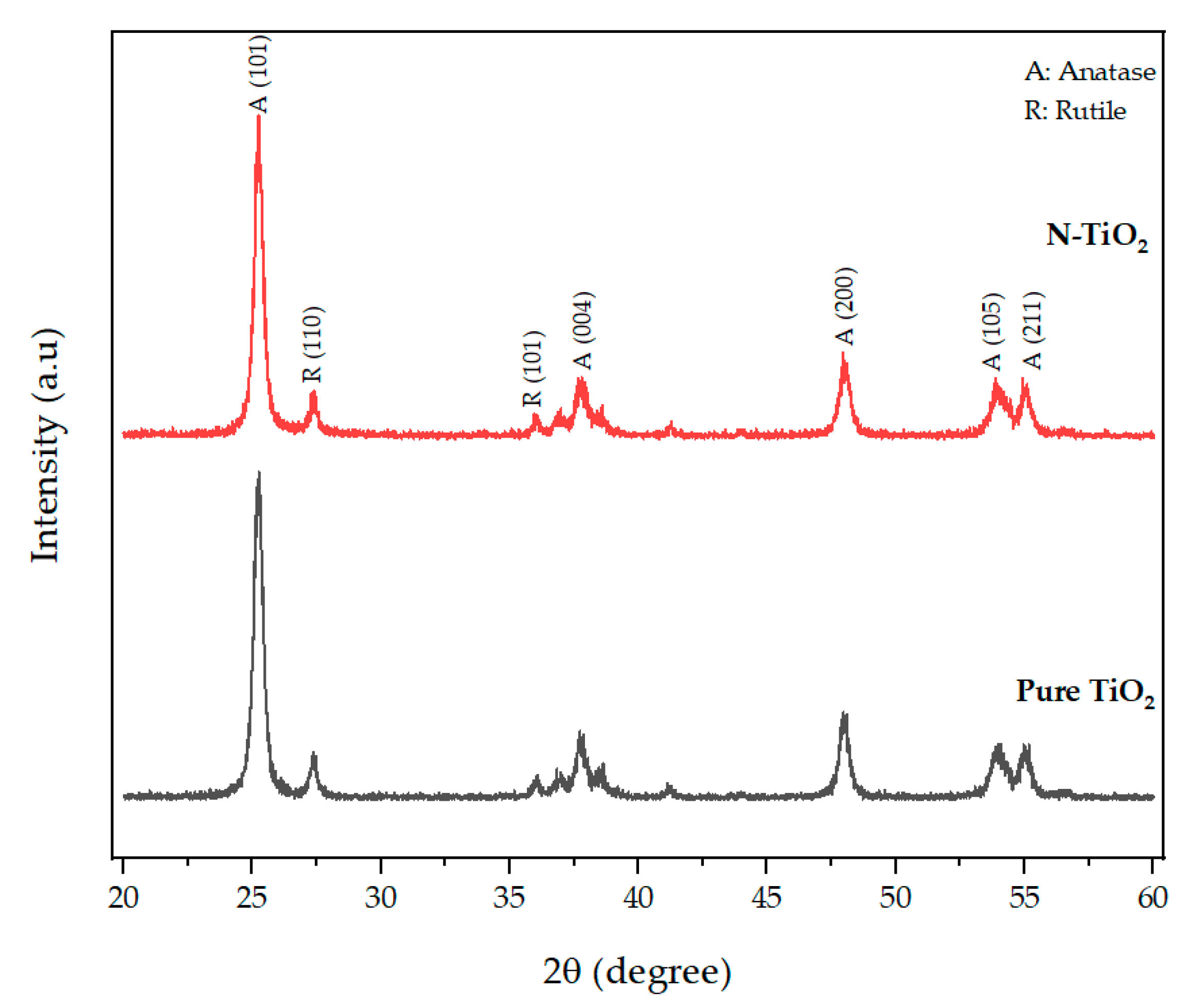

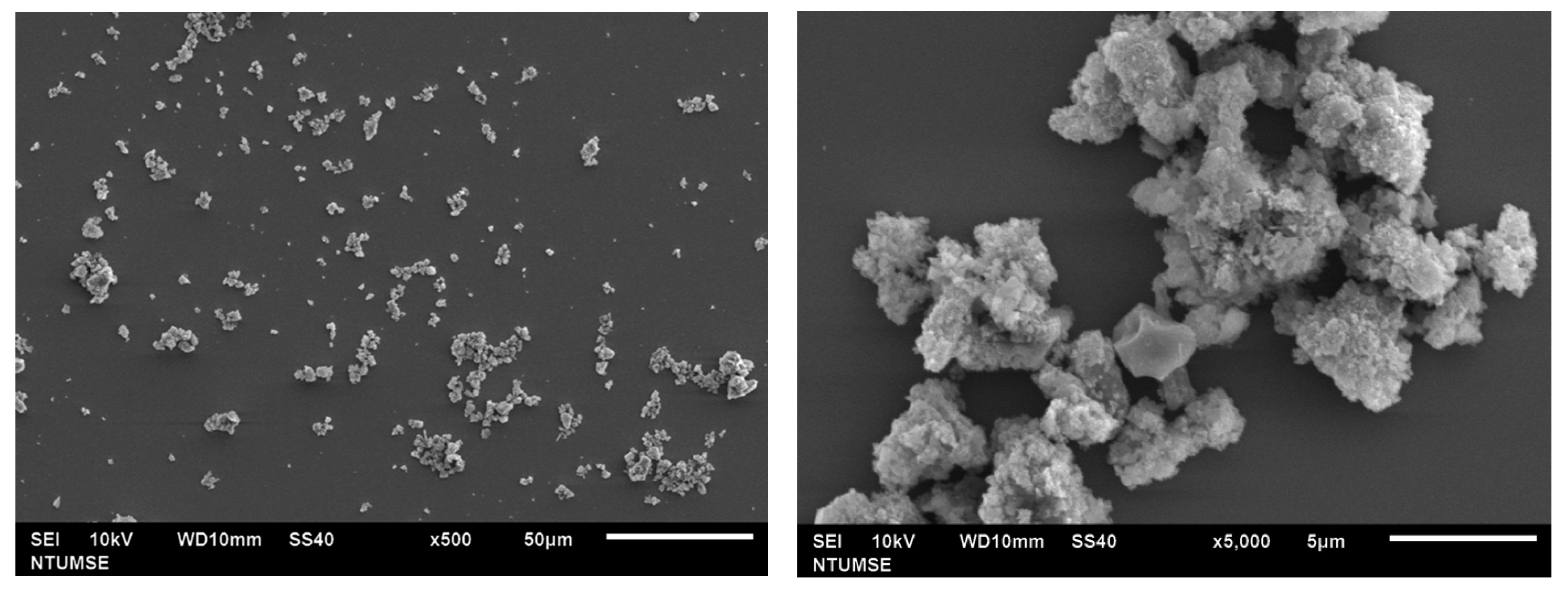

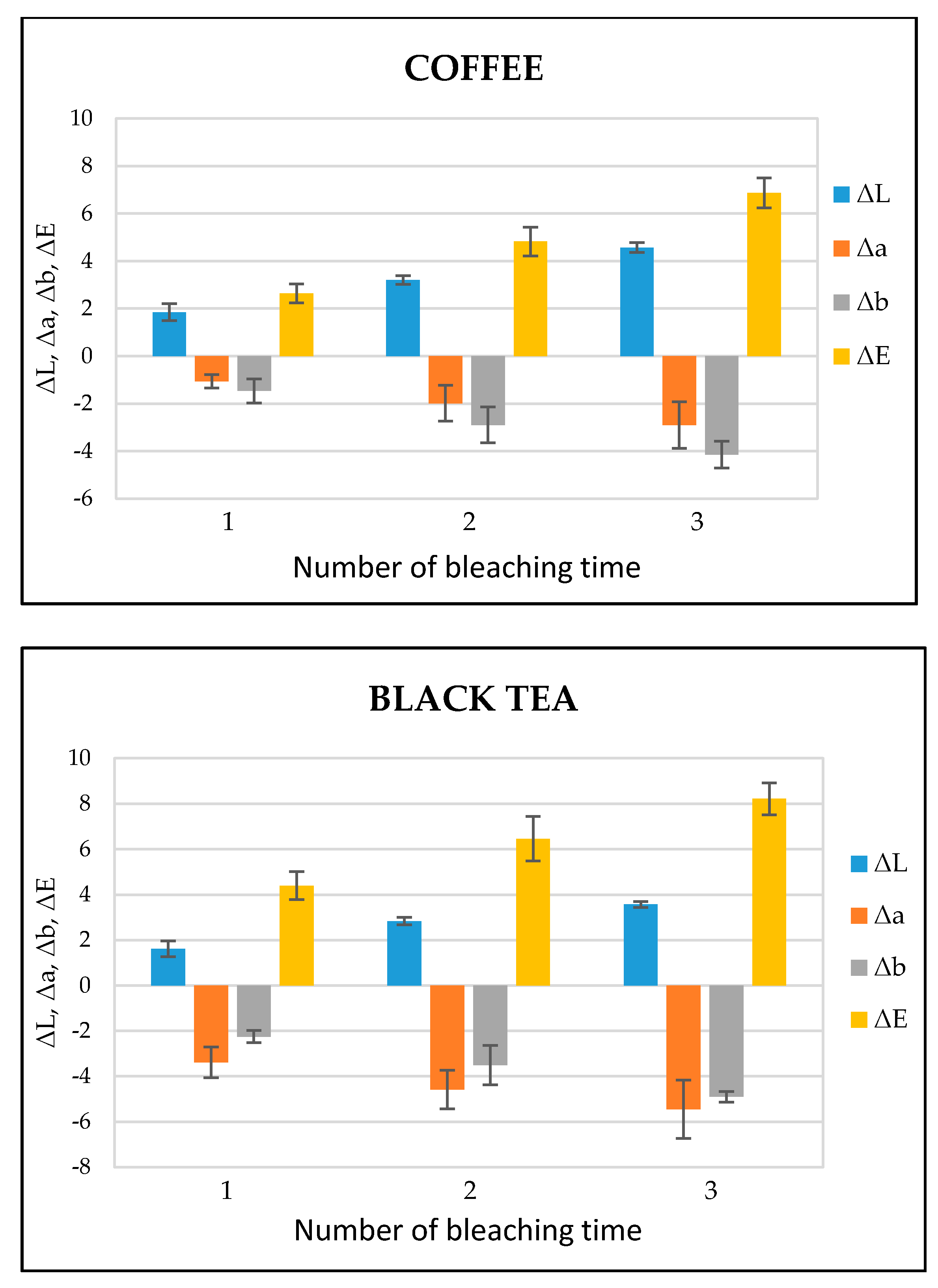
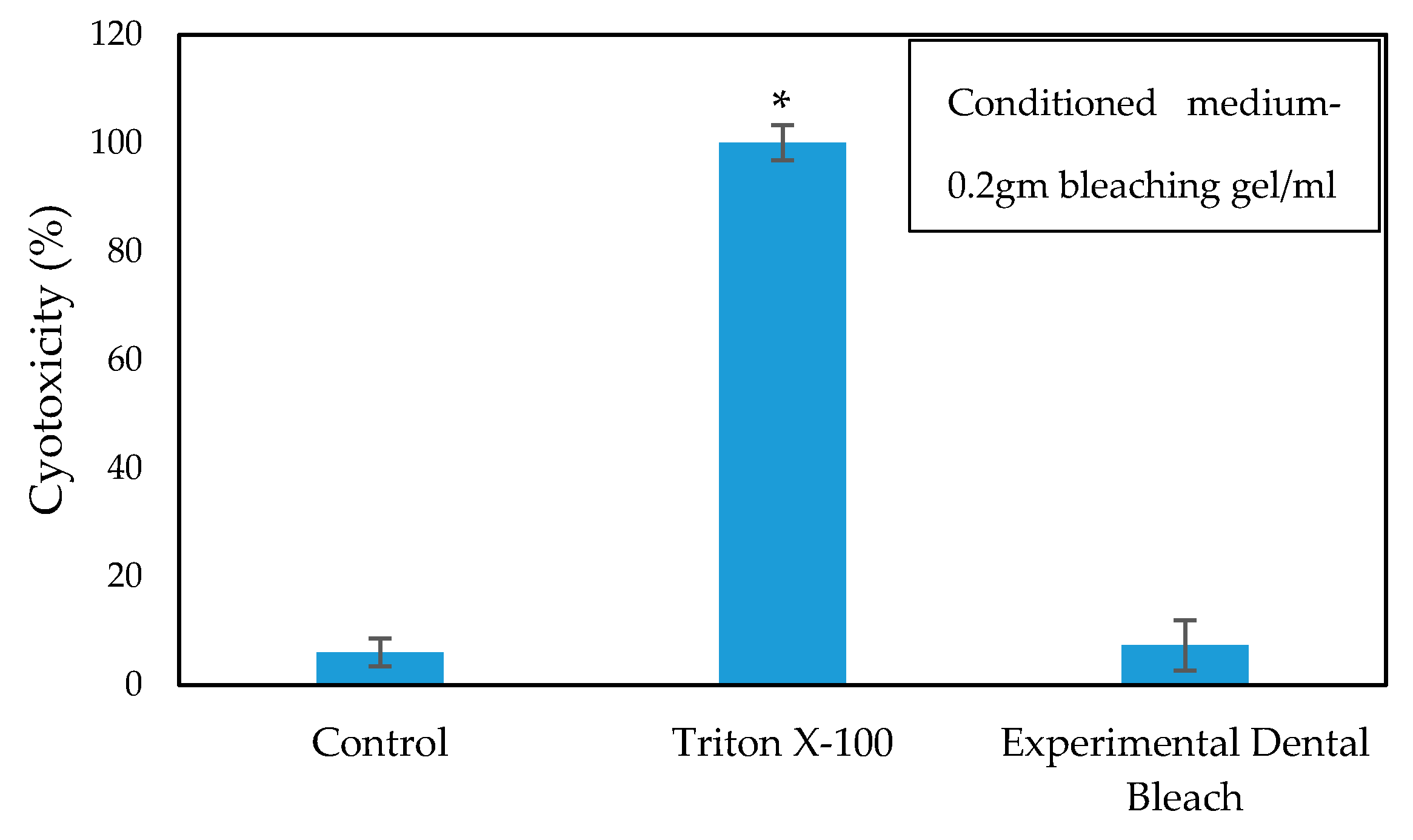
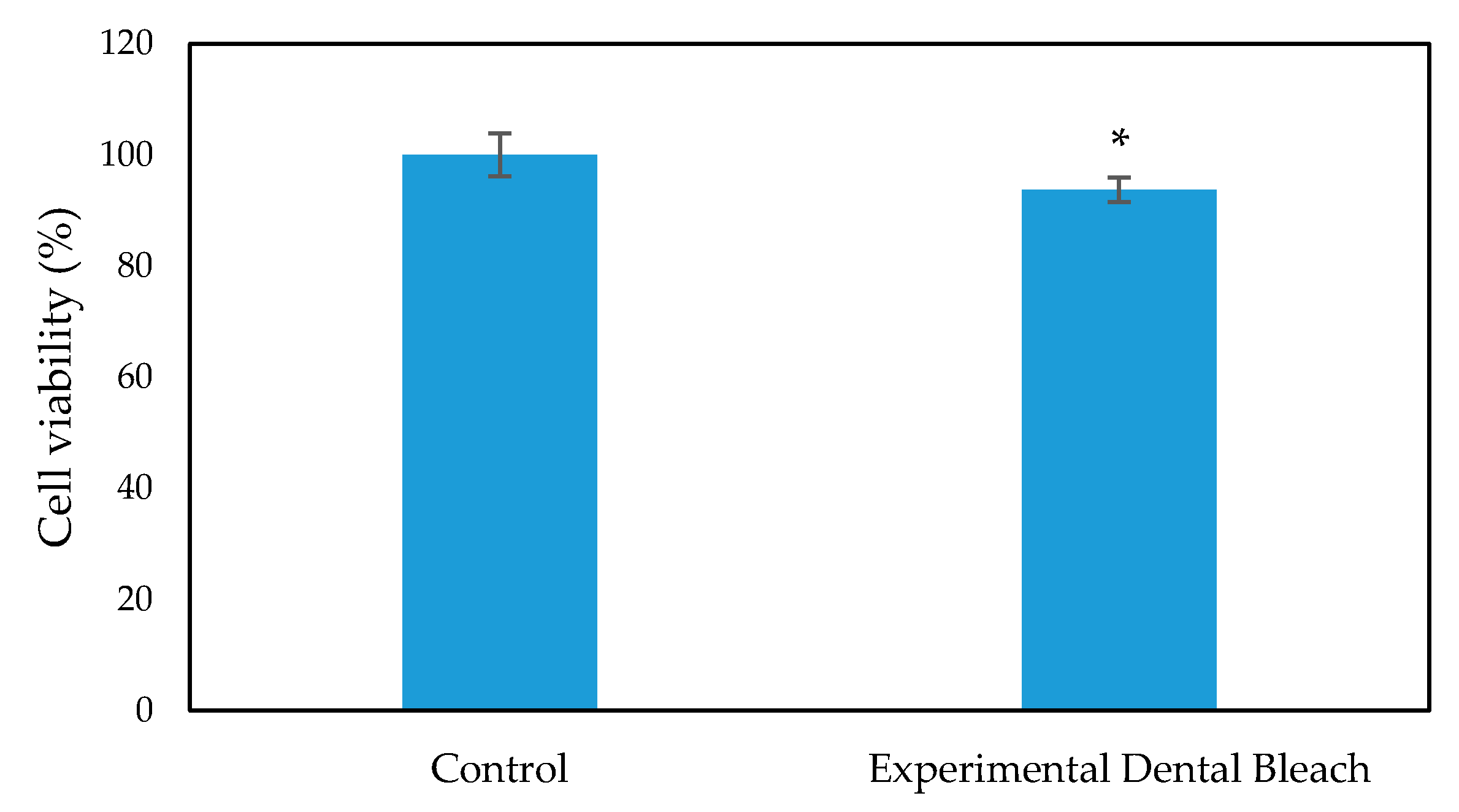
| Mean ΔE (SD) | |||
|---|---|---|---|
| Solution | Times | ||
| 1 | 2 | 3 | |
| Coffee | 2.638 (0.392) a | 4.822 (0.601) b | 6.874 (0.629) c |
| Black Tea | 4.362 (0.589) a | 6.460 (0.973) b | 8.213 (0.705) c |
Publisher’s Note: MDPI stays neutral with regard to jurisdictional claims in published maps and institutional affiliations. |
© 2021 by the authors. Licensee MDPI, Basel, Switzerland. This article is an open access article distributed under the terms and conditions of the Creative Commons Attribution (CC BY) license (https://creativecommons.org/licenses/by/4.0/).
Share and Cite
Thacker, M.; Chen, Y.-N.; Lin, C.-P.; Lin, F.-H. Nitrogen-Doped Titanium Dioxide Mixed with Calcium Peroxide and Methylcellulose for Dental Bleaching under Visible Light Activation. Int. J. Mol. Sci. 2021, 22, 3759. https://doi.org/10.3390/ijms22073759
Thacker M, Chen Y-N, Lin C-P, Lin F-H. Nitrogen-Doped Titanium Dioxide Mixed with Calcium Peroxide and Methylcellulose for Dental Bleaching under Visible Light Activation. International Journal of Molecular Sciences. 2021; 22(7):3759. https://doi.org/10.3390/ijms22073759
Chicago/Turabian StyleThacker, Minal, Yi-Ning Chen, Chun-Pin Lin, and Feng-Huei Lin. 2021. "Nitrogen-Doped Titanium Dioxide Mixed with Calcium Peroxide and Methylcellulose for Dental Bleaching under Visible Light Activation" International Journal of Molecular Sciences 22, no. 7: 3759. https://doi.org/10.3390/ijms22073759
APA StyleThacker, M., Chen, Y.-N., Lin, C.-P., & Lin, F.-H. (2021). Nitrogen-Doped Titanium Dioxide Mixed with Calcium Peroxide and Methylcellulose for Dental Bleaching under Visible Light Activation. International Journal of Molecular Sciences, 22(7), 3759. https://doi.org/10.3390/ijms22073759







